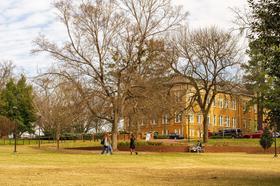Rhode Island is the #48 largest school system in the United States, serving 134,720 students across the 315 public schools for the 2025-26 school year (there are , serving 22,705 students). 86% of all K-12 students in Rhode Island attend public schools, compared to the national average of 90%.
The percentage of students achieving math proficiency in Rhode Island is 29%. The percentage of students achieving reading proficiency is 33%.
The top-ranked public schools in Rhode Island are Nayatt School, Barrington High School, and Community School. Overall testing rank is based on a school's combined math and reading proficiency test scores.
Minority enrollment is 49%, with the majority being Hispanic and the student-teacher ratio is 13:1.
Top Ranked Public Schools in Rhode Island (2025-26)
School
(Math and Reading Proficiency)
(Math and Reading Proficiency)
Student Proficiency
Grades
Location
Rank: #11.
Nayatt School
(Math: 70-74% | Reading: 75-79%)
Rank:
Rank:
10/
Top 1%10
Math: 70-74% (Top 5%)
Reading: 75-79% (Top 5%)
Grades: K-3
400 Nayatt Road
Barrington, RI 02806
(401) 247-3175
Barrington, RI 02806
(401) 247-3175
Rank: #22.
Barrington High School
(Math: 69% | Reading: 83%)
Rank:
Rank:
10/
Top 1%10
Math: 69% (Top 5%)
Reading: 83% (Top 1%)
Grades: 9-12
220 Lincoln Avenue
Barrington, RI 02806
(401) 247-3150
Barrington, RI 02806
(401) 247-3150
Rank: #33.
Community School
(Math: 76% | Reading: 69%)
Rank:
Rank:
10/
Top 5%10
Math: 76% (Top 1%)
Reading: 69% (Top 5%)
Grades: K-5
15 Arnold Mills Road
Cumberland, RI 02864
(401) 333-5724
Cumberland, RI 02864
(401) 333-5724
Rank: #44.
Sowams Elementary School
(Math: 70-79% | Reading: 65-69%)
Rank:
Rank:
10/
Top 5%10
Math: 70-79% (Top 1%)
Reading: 65-69% (Top 5%)
Grades: K-3
364 Sowams Road
Barrington, RI 02806
(401) 247-3180
Barrington, RI 02806
(401) 247-3180
Rank: #55.
Jamestown School-melrose
(Math: 70-74% | Reading: 65-69%)
Rank:
Rank:
10/
Top 5%10
Math: 70-74% (Top 5%)
Reading: 65-69% (Top 5%)
Grades: PK-4
76 Melrose Avenue
Jamestown, RI 02835
(401) 423-7020
Jamestown, RI 02835
(401) 423-7020
Rank: #66.
East Greenwich High School
(Math: 60-64% | Reading: 80-84%)
Rank:
Rank:
10/
Top 5%10
Math: 60-64% (Top 10%)
Reading: 80-84% (Top 5%)
Grades: 9-12
300 Avenger Drive
East Greenwich, RI 02818
(401) 398-1300
East Greenwich, RI 02818
(401) 398-1300
Rank: #77.
Barrington Middle School
(Math: 63% | Reading: 72%)
Rank:
Rank:
10/
Top 5%10
Math: 63% (Top 5%)
Reading: 72% (Top 5%)
Grades: 6-8
261 Middle Highway
Barrington, RI 02806
(401) 247-3160
Barrington, RI 02806
(401) 247-3160
Rank: #88.
Narragansett Elementary School
(Math: 70-74% | Reading: 60-64%)
Rank:
Rank:
10/
Top 5%10
Math: 70-74% (Top 5%)
Reading: 60-64% (Top 10%)
Grades: PK-4
55 Mumford Road
Narragansett, RI 02882
(401) 792-9420
Narragansett, RI 02882
(401) 792-9420
Rank: #99.
James H. Eldredge School
(Math: 70% | Reading: 65%)
Rank:
Rank:
10/
Top 5%10
Math: 70% (Top 5%)
Reading: 65% (Top 10%)
Grades: 3-5
101 First Avenue
East Greenwich, RI 02818
(401) 886-3246
East Greenwich, RI 02818
(401) 886-3246
Rank: #1010.
Clayville School
(Math: 60-64% | Reading: 65-69%)
Rank:
Rank:
10/
Top 5%10
Math: 60-64% (Top 10%)
Reading: 65-69% (Top 5%)
Grades: PK-5
3 George Washington Highway
Clayville, RI 02815
(401) 647-4115
Clayville, RI 02815
(401) 647-4115
Overview
This State (RI)
# Schools
315 Schools
# Students
134,720 Students
Gender %
# Teachers
10,603 Teachers
Student-Teacher Ratio
13:1
Student By Grade
State Acdeamy
State Average (RI)
Math Test Scores (% Proficient)
29%
Reading/Language Arts Test Scores (% Proficient)
35%
Science Test Scores (% Proficient)
30%
Graduation Rate
83%
Eligible for Free Lunch
38%
Eligible for Reduced Lunch
6%
Students by Ethnicity:
Diversity Score
0.65
# American Indian Students
985 Students
% American Indian Students
1%
# Asian Students
4,367 Students
% Asian Students
4%
# Hispanic Students
40,594 Students
% Hispanic Students
30%
# Black Students
12,033 Students
% Black Students
9%
# White Students
68,392 Students
% White Students
51%
# Hawaiian Students
204 Students
% Hawaiian Students
n/a
# Two or more races Students
6,910 Students
% of Two or more races Students
5%
All Ethnic Groups
State Revenue and Spending
This State (RI)
Total Revenue
$2,998 MM
Spending
$2,892 MM
Revenue / Student
$22,250
Spending / Student
$21,467
Best Rhode Island Public Schools by County (2025-26)
Popular neighborhoods: Lower South Providence (8 schools), Federal Hill (7 schools), West End (7 schools), Hartford (6 schools), Valley Falls (5 schools).
County
# Schools
# Students
% Minority
Frequently Asked Questions
What are the top ranked public schools in Rhode Island?
The top-ranked public schools in Rhode Island include Nayatt School, Barrington High School, and Community School.
How many public schools are located in Rhode Island?
315 public schools are located in Rhode Island.
What percentage of students in Rhode Island go to public school?
86% of all K-12 students in Rhode Island attend public schools (compared to the national average of 90%).
What is the racial composition of students in Rhode Island?
Minority enrollment in Rhode Island is 49%, with the majority being Hispanic.
Which public schools in Rhode Island are often viewed compared to one another?
Popular comparisons of public schools in Rhode Island include: Nathanael Greene Middle School vs. Nathan Bishop Middle School, Riverside Middle School vs. Edward Martin Middle School, Cranston High School East vs. Cranston High School West
Recent Articles

School Vouchers 2025: Updated Pros and Cons
A 2025 update on school vouchers, including benefits, drawbacks, enrollment trends, and how vouchers affect public and private education.

The Role of Arts in Public Schools (2025 Update)
Explore why arts education remains vital in U.S. public schools, with updated data, new policy context, and insights for parents, students, and educators.

The Role of Sports in Public Schools in 2025
How sports in public schools shape learning, health, and community in 2025, with updated data, trends, and expert insights.





